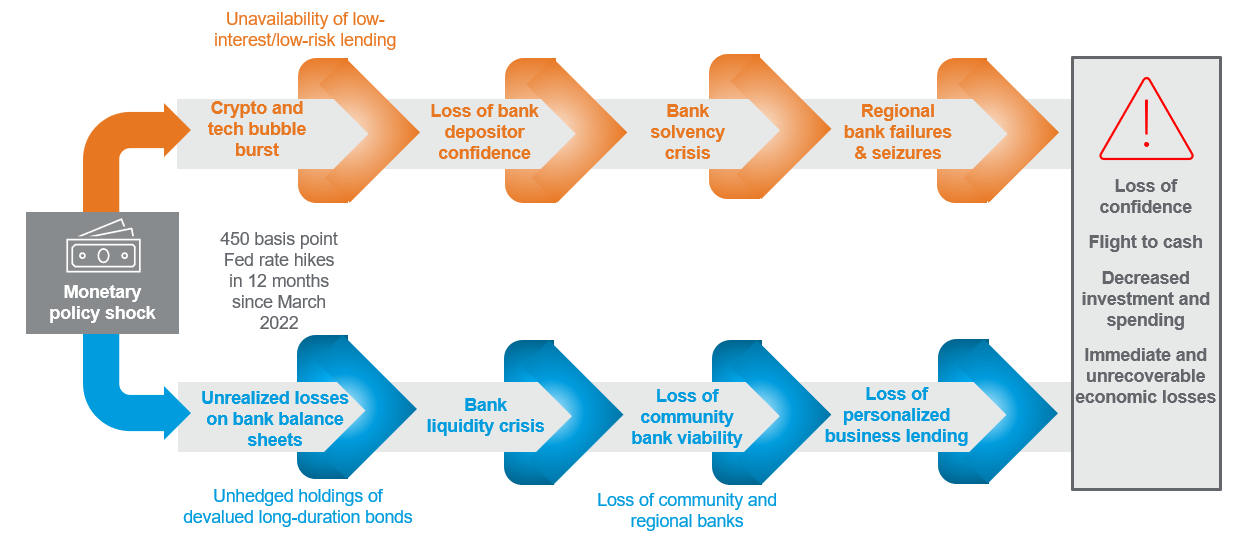ARTICLE | March 13, 2023
Authored by RSM US LLP
With a crisis growing among the nation’s regional and midsize banks, the Federal Reserve, Treasury Department and Federal Deposit Insurance Corporation took decisive action over the weekend to stem a potential bank run.
The $25 billion Bank Term Funding Program, announced on March 12 after several days of mounting concern over the health of the nation’s banking system, was necessary to prevent a bank run that would almost certainly tip the economy into recession.
The lending program will help the nation’s small and midsize banks restore their balance sheets that now have unrealized losses in long-term, low-interest securities following aggressive rate increases by the Federal Reserve.
Under the program, if a bank owns bonds that are trading at 60 cents to the dollar, it can exchange those bonds at the Fed’s discount window for $1 in liquidity. effectively removing the risk of insolvency and a bank run.
What’s more, it potentially clears the way for the Fed to increase its policy rate by 25 basis points on March 22, at its next policy meeting.
But the Fed will want to strike a careful balance between restoring price stability and financial stability so soon after such an extreme event as the bank seizures.
“The primary policy objective of the BTFP is to restore confidence in the banking system and protect the real economy.”
The run-up
Bank runs cause real economic damage, and the action taken by the Fed, Treasury and FDIC intends to avoid a much larger and more expensive set of policies later.
The time to stop a bank run is before it begins. The absence of a “white knight” stepping forward over the weekend necessitated the large and decisive action taken.
The series of bank collapses and seizures in the days running up to the Fed’s announcement created the conditions for a classic run on banks that borrow short and lend long.
The mix of illiquid assets like business or mortgage loans and liquid liabilities like deposits, which may be withdrawn at any time, can easily give rise to self-fulfilling panics.
That is an apt description of the current moment and is what necessitated the creation of the $25 billion financing program.
At issue is the roughly $620 billion in unrealized losses sitting on the balance sheets of the nation’s banks. After a year of relentless increases in interest rates, many of these banks, particularly smaller and midsize institutions, sit on Treasury and agency-issued mortgage-backed securities that have lost value.
In the end, many depository institutions ended up borrowing short and lending long—what one might refer to as a carry trade—and the strategy imploded. With rates likely to move higher, perhaps to 6% by midyear, those unrealized losses will grow and could place other banks that adopted similar strategies under further stress.
Confluence of an asset-bubble burst and a policy-shock, leading to a bank run, a flight to cash and a threat to economic growth
How the Bank Term Funding Program works
The primary policy objective of the BTFP is to restore confidence in the banking system and protect the real economy.
In our estimation the policy approach put forward is the appropriate framework to address a liquidity crisis.
The BTFP offers loans of up to one year to banks, savings associations, credit unions and other eligible depository institutions pledging U.S. Treasury bonds, agency debt and mortgage-backed securities, and other qualifying assets as collateral.
These assets will be valued at par. The BTFP will be an additional source of liquidity against high-quality securities, eliminating an institution’s need to quickly sell those securities in times of stress.
Depository institutions may obtain liquidity against a wide range of collateral through the discount window, which remains open. In addition, the discount window will apply the same margins used for the securities eligible for the BTFP, further increasing lendable value at the window.
While all depositors will be made whole, shareholders and certain unsecured debtholders will not be protected. Senior management has also been removed. Any losses to the Deposit Insurance Fund to support uninsured depositors will be recovered by a special assessment on banks, as required by law.
This is a policy put in place to protect deposits and is not a bailout of the bank, shareholders or debtholders.
The Federal Reserve also announced it will make available additional funding to eligible depository institutions to help ensure banks have the ability to meet the needs of all their depositors.
Do you have questions or want to talk to a LaPorte professional?
Fill out the form below and we’ll contact you to discuss your situation.
This article was written by Joe Brusuelas and originally appeared on Mar 13, 2023.
2022 RSM US LLP. All rights reserved.
https://rsmus.com/insights/economics/bank-term-funding-program-government-response-banking-crisis.html
RSM US Alliance provides its members with access to resources of RSM US LLP. RSM US Alliance member firms are separate and independent businesses and legal entities that are responsible for their own acts and omissions, and each is separate and independent from RSM US LLP. RSM US LLP is the U.S. member firm of RSM International, a global network of independent audit, tax, and consulting firms. Members of RSM US Alliance have access to RSM International resources through RSM US LLP but are not member firms of RSM International. Visit rsmus.com/about us for more information regarding RSM US LLP and RSM International. The RSM logo is used under license by RSM US LLP. RSM US Alliance products and services are proprietary to RSM US LLP.

LaPorte CPAs & Business Advisors is a proud member of the RSM US Alliance, a premier affiliation of independent accounting and consulting firms in the United States. RSM US Alliance provides our firm with access to resources of RSM US LLP, the leading provider of audit, tax and consulting services focused on the middle market. RSM US LLP is a licensed CPA firm and the U.S. member of RSM International, a global network of independent audit, tax and consulting firms with more than 43,000 people in over 120 countries.
Our membership in RSM US Alliance has elevated our capabilities in the marketplace, helping to differentiate our firm from the competition while allowing us to maintain our independence and entrepreneurial culture. We have access to a valuable peer network of like-sized firms as well as a broad range of tools, expertise, and technical resources.
For more information on how LaPorte CPAs & Business Advisors can assist you, please call 713.548.2034.


